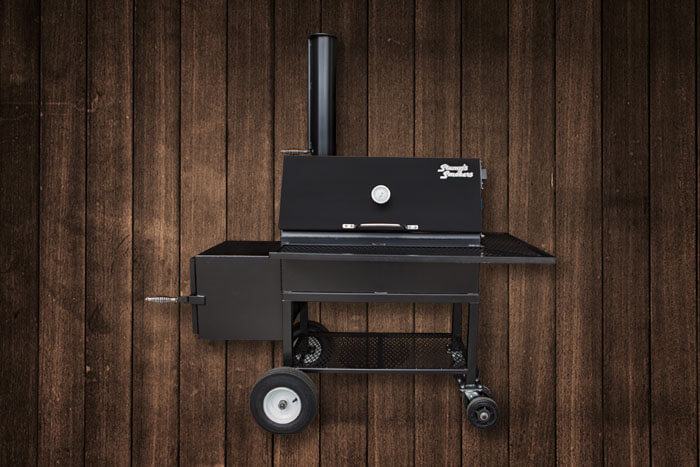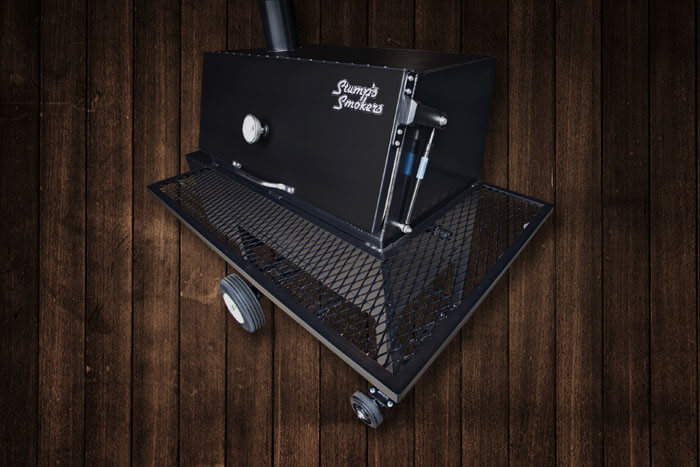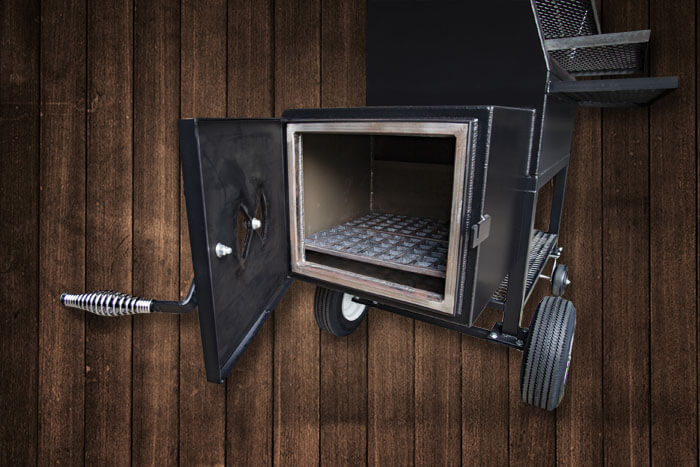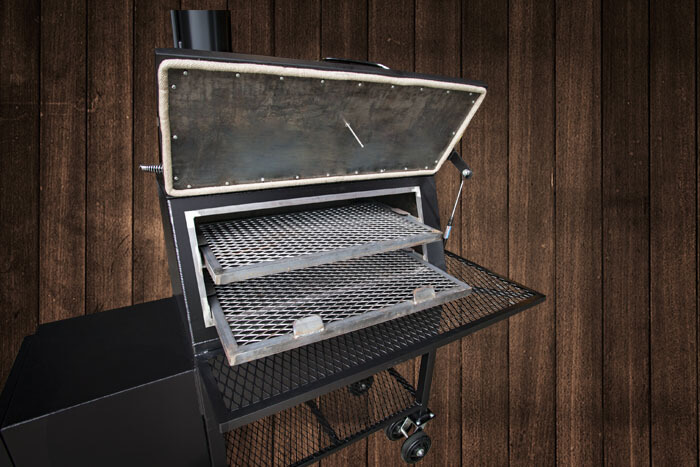REVERSE FLOW 3X2
The smallest in our line of Reverse Flow Smokers. This unit is the perfect unit for the backyard enthusiast who desires to cook low and slow to obtain the real wood flavor. Cooking with the combination of charcoal and wood brings out that old time Southern BBQ flavor.
BASE PRICE $3,250.00
REVERSE FLOW 3X2 SPECIFICATIONS
| Overall Dimensions | 59 1/2″H x 35″W x 30″D |
| Metal Thickness | 3/16″ Metal |
| Overall Weight | 350 lbs. |
| Cook Temp Range | 175 – 450 degrees |
| Charcoal Qty | 10 lbs. |
| Bottom Rack Size | 29″W x 18 3/8″D |
| Top Rack Size | 29″W x 16 3/8″D |
| Rack Spacing | 6″ apart |
| # of Rack Runners | (2) Runners |
| # of Racks | (2) Racks |
| Color | Black |
| Casters | (2) 4.5? Dual Casters & (2) Pneumatic Wheels |
| Door Handles | Cadium |
| Thermometer | Chrome Stump’s BBQ Thermometer in door |
| Standard Features | Solid welded interior Insulated and Gasketed cook door Cool Touch Door Handles 1200 degree High Temperature Paint Finish Full Size, Charcoal Tray Full Size, Ash Pan 24” Tall Adjustable Exhaust Stack w/Rain Cap Adjustable Firebox Damper Hydraulic Door Shock |
OPTIONAL ACCESSORIES
| Full Size Removable 3″ Deep “Heavy Duty” Water Pan | $175.00 |
| (4) D-Ring Tie Downs | $60.00 |
| Replacement Gasket per/ft | $5.68 |
| Replacement Thermometer | $35.00 |
| Replacement Rack | $45.00 |
CAPACITY
| Baby Back Ribs | 10 |
| St. Louis Style Ribs | 8 |
| Large Brisket | 6 |
| Boston Butts | 6 |
| Chicken Halves | 20 |
ORDER THIS COOKER

FREQUENTLY ASKED QUESTIONS
A Reverse Flow Smoker is an indirect heat smoker. This means there is a fuel off to the side and natural air movement and draw is used to move the heated air thru into the cook chamber. As it is drawn along under our vallified diverter plate the heat is evenly distributed across all areas of the cooker’s bottom pan as it moves under the plate to the end, then it reverses itself and flows (thus the nick name reverse-flow) and drafts back over the top of the heated diverter before exiting through the smoke stack.
The amount of “fire” is controlled by the amount of oxygen that is allowed in from the adjustable air dampers on front of the firebox. In this type setup the fire basket-full of fuel can all ignite at one time because oxygen is more prevalent in this type setup. So the burning area of fuel is of greater proportion in fire basket. At the rear of the firebox there is a opening that allows the heat/smoke to transfer from the firebox into the cook chamber.
So by controlling the amount of oxygen that is fed in, we can control the amount of “fire” inside the firebox and the temp and airflow as it moves through the cook chamber. Allowing the natural draft of the cooker to move the oxygen in will allow the temp to rise faster (helping to recover the heat in the cook chamber after the door has been opened). Letting it recover naturally through the air dampers is ALWAYS a better judgment than by leaving the door open. It takes a little longer but the control of the burn is more precise and will not allow a fire to get too hot.|
The heat/smoke moves through the cook chamber in a Reverse Flow Smoker much faster, therefore the cook chamber tends to be a drier environment thus lending for a lower and slower approach to create a nice moist cooking environment that doesn’t tend to cause meat to dry out as it is cooking.
The 3 X 2 operates primarily with charcoal as the heat source and wood chunks for flavor. Most cooks who uses a small Reverse Flow prefer split wood as the source of chunks for both the heat and flavor.
Wood selection is a matter of the Cook’s palette. Therefore, we have included some basic guidelines for selection. A wood that is going to be used should be either fruit or nut bearing. The most prevalent smoking woods include oak, hickory, pecan, peach, apple, cherry, and mesquite. The fruit woods produce a mild flavor with a slightly sweet finish. The oaks and other hardwoods produce a heartier smoke flavor and pecan can influence some meats with a hint of sweet. Flavor wood will also influence the color of the meat. Some pit-masters like to mix cherry and pecan which produces a cherry like color on the bark and a slight sweet smoke flavor. The other consideration when selecting wood is seasoned vs. green. Experienced pit-masters choose seasoned wood. Seasoned wood burns more predictably, which contributes to a cleaner burning fire and minimizes temperature spikes making pit management easier.
COOKER MANUALS
TESTIMONIALS
Lorem ipsum dolor sit amet, consectetur adipiscing elit. Fusce at vehicula est, sit amet rutrum mi. Donec sagittis, diam quis commodo consequat, sem diam tempor ex, sit amet tincidunt elit mauris eget orci. Ut faucibus turpis at ex luctus commodo. Mauris at ante fermentum, posuere arcu vitae, viverra est. Vestibulum fringilla blandit leo lacinia ultrices. Ut lobortis molestie mi a malesuada. Etiam mattis nunc eget risus porta, vel convallis est eleifend. Fusce eleifend diam id sapien hendrerit, nec fringilla lacus condimentum. In in bibendum enim, quis pharetra elit. Ut nec justo sed sem rhoncus auctor id quis nunc. Vestibulum eu enim aliquam purus semper porttitor eu a nisi. Praesent vitae neque ornare, ornare nisl ullamcorper, efficitur tellus. Donec consectetur diam quis convallis scelerisque.Integer ut suscipit eros, sed malesuada ipsum. Cras ullamcorper nec quam sed volutpat. Interdum et malesuada fames ac ante ipsum primis in faucibus. Nunc erat est, pellentesque ac volutpat non, semper quis lorem. Sed mattis dui at neque mattis pharetra. Morbi blandit lacinia nisi, nec lobortis eros faucibus et. Nullam at velit sagittis quam sollicitudin faucibus. Sed pellentesque faucibus lorem sit amet tempus. Pellentesque sit amet facilisis ipsum.
Lorem ipsum dolor sit amet, consectetur adipiscing elit. Fusce at vehicula est, sit amet rutrum mi. Donec sagittis, diam quis commodo consequat, sem diam tempor ex, sit amet tincidunt elit mauris eget orci. Ut faucibus turpis at ex luctus commodo. Mauris at ante fermentum, posuere arcu vitae, viverra est. Vestibulum fringilla blandit leo lacinia ultrices. Ut lobortis molestie mi a malesuada. Etiam mattis nunc eget risus porta, vel convallis est eleifend. Fusce eleifend diam id sapien hendrerit, nec fringilla lacus condimentum. In in bibendum enim, quis pharetra elit. Ut nec justo sed sem rhoncus auctor id quis nunc. Vestibulum eu enim aliquam purus semper porttitor eu a nisi. Praesent vitae neque ornare, ornare nisl ullamcorper, efficitur tellus. Donec consectetur diam quis convallis scelerisque.Integer ut suscipit eros, sed malesuada ipsum. Cras ullamcorper nec quam sed volutpat. Interdum et malesuada fames ac ante ipsum primis in faucibus. Nunc erat est, pellentesque ac volutpat non, semper quis lorem. Sed mattis dui at neque mattis pharetra. Morbi blandit lacinia nisi, nec lobortis eros faucibus et. Nullam at velit sagittis quam sollicitudin faucibus. Sed pellentesque faucibus lorem sit amet tempus. Pellentesque sit amet facilisis ipsum.






